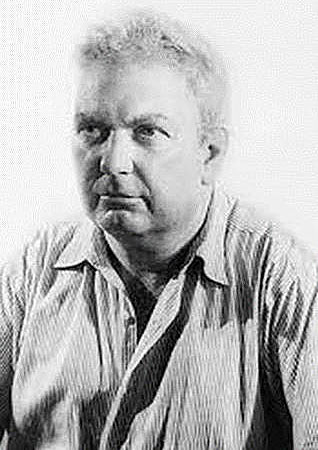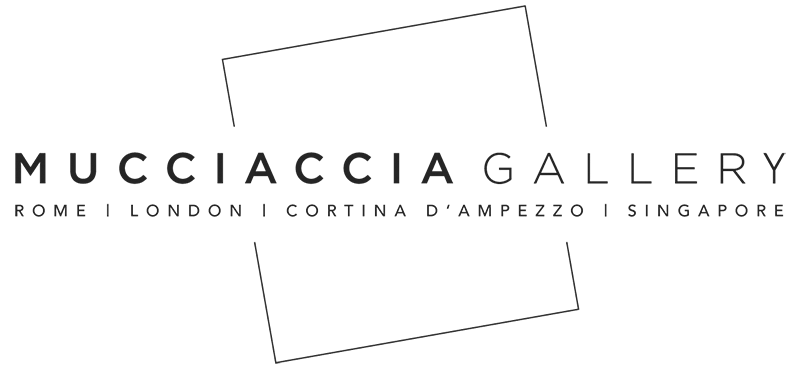Alexander Calder
Alexander Calder was born in 1898, the second son in a family of artists: his father was a sculptor, his mother a painter. His parents encouraged him to be creative, and from the age of eight Alexander always had his own studio wherever the family lived. At Christmas 1909 he gave his parents two of his first works: a small dog and a duck made by cutting out and shaping a sheet of brass; the duck is a kinetic sculpture, with a tap it swings back and forth. He was only eleven years old, but his ease in handling materials was evident.
Although he was so gifted, the young man did not immediately embark on an artistic career. For several years, he worked in a wide variety of jobs: as a hydraulic engineer and in the automobile industry, as a time supervisor in a logging and timber yard, and as a stoker in the boiler room of a ship.
In 1923 Calder moved to New York and enrolled in the Art Students League, an unconventional art school. In addition, the National Police Gazette hired him as a draftsman, and in 1925 commissioned him to follow the Ringling Brothers and Barnum & Bailey circuses for a fortnight, illustrating their performances in a series of sketches. The sculptor would never abandon his interest in the circus; after moving to Paris in 1926, he created the Cirque Calder [Calder Circus], a complex and unrepeatable work created as an assemblage of tiny performers, animals, and props similar to those used by the Ringling Brothers, made of wire, leather, cloth, and various recycled materials. Calder had designed it in such a way that it could be manoeuvred by hand; each piece was small enough to fit into a large trunk, which the artist carried with him, thus being able to put on a show wherever he went. The first one took place in Paris in front of an audience of friends and colleagues and was followed by a series of performances, in Paris as well as in New York, which were very successful.
The artist discovered that he liked to work with wire for his circus, and soon began to carve sculptures from this material in which he portrayed friends and prominent figures of the time. In 1928, when the fame of his inventive faculties had begun to spread, the Weyhe Gallery in New York presented him with a first solo exhibition, soon followed by other exhibitions, again in New York and then in Paris and Berlin. As a result, Calder spent a lot of time travelling on ocean liners between Europe and America, and it was during one of these crossings that he met Louisa James (the writer Henry James was his great-uncle), to whom he married in January 1931. At the same time, the sculptor made friends with many artists and intellectuals who had become famous in the early 20th century: Joan Miró, Fernand Léger, James Johnson Sweeney, Marcel Duchamp. In October 1930, while visiting Piet Mondrian’s Parisian studio, Calder was deeply impressed by a wall completely strewn with coloured cardboard rectangles, which the painter continuously moved for his compositional experiments. As the artist recounted in later years, the episode had “shocked” him, orienting him definitively towards total abstractionism. During the three weeks after being in Mondrian’s studio, he devoted himself exclusively to abstract paintings, but this only served to make him realise that his preference was in fact for sculpture. Shortly afterwards he was invited to join Abstraction-Création [Abstraction-Creation], an influential group of artists (including Arp, Mondrian, Hélion) with whom he had become friends.
The autumn of 1931 marked an important turning point in his creative journey: Calder created his first true kinetic sculpture, giving rise to an entirely new artistic genre. For the first object of this kind, made mobile by a system of cranks and motors, Marcel Duchamp found the term ‘mobile’, a French word comparable to the Italian ‘movente’, which contains an allusion to motion but also to motivation. Shortly afterwards, the sculptor would renounce the mechanical aspects of these works, realising that he could make mobiles capable of oscillating by themselves thanks to air currents. To distinguish Calder’s non-kinetic works from the others, the fixed objects, Jean Arp christened them ‘stabiles’.
In 1933, the Calders left France and returned to the United States, where they purchased an old farmhouse in Roxbury, Connecticut, to which was attached a room that had once been used as an icehouse: this, renovated, became the artist’s studio. During the 1930s the artist also designed sets for Martha Graham’s and Eric Satie’s ballets and continued to present Cirque Calder shows.
In the same decade Calder also began to try his hand at large-scale outdoor sculptures. In 1937 he created his first large-scale building (an enlarged version of an earlier building), bolted together and made entirely of metal sheets, to which he gave the title Devil Fish. The work was presented by the Pierre Matisse Gallery in the exhibition Stabiles and Mobiles, which also featured Big Bird, another large sculpture made from a smaller model. Shortly afterwards Calder was commissioned to execute Mercury Fountain for the Spanish pavilion at the Paris World’s Fair (a work that symbolised the resistance to fascism by Spanish republicans) and Lobster Trap and Fish Tail, a large piece of furniture placed in the main stairwell of the Museum of Modern Art in New York.
When the United States entered the war, there was a shortage of metal materials, so Calder began to make increasing use of wood, leading to a further genre of original sculptures, which Sweeney and Duchamp called ‘constellations.
In the 1940s and 1950s Calder had a considerable artistic productivity, which was inaugurated in 1939 with the first retrospective of his work at the George Walter Vincent Smith Gallery in Springfield, Massachusetts. In 1949, the artist created the largest piece of furniture he had ever made, International Mobile, to be presented in the Third International Sculpture Exhibition at the Museum of Art in Philadelphia. In 1950 the Galerie Maeght in Paris also presented an exhibition of his work, and later became his exclusive dealer in Paris, a relationship that was to last for twenty-six years until Calder’s death in 1976. By the 1960s Calder was recognised worldwide as an artist of great talent. In 1964, the Guggenheim Museum in New York put on a retrospective exhibition of his work; five years later, the Maeght Foundation in Saint-Paul-de-Vence celebrated him in turn with a retrospective exhibition.
In 1976, the sculptor attended the opening of another retrospective, entitled Calder’s Universe, at the Whitney Museum of American Art in New York. He passed away at the age of seventy-eight a few weeks later in New York.


